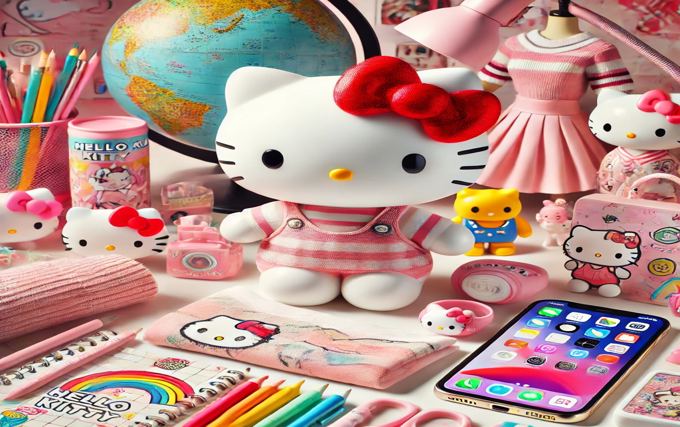Hello Kitty, the adorable character with a distinctive red bow and no visible mouth, has captured hearts worldwide since her debut in 1974. Created by Japanese company Sanrio, Hello Kitty has transcended cultural boundaries, becoming a symbol of cuteness, nostalgia, and joy. In this article, we explore Hello Kitty’s origins, her cultural impact, merchandise empire, and her relevance in modern pop culture.
The Origins of Hello Kitty
The Birth of a Cultural Icon
Hello Kitty was born out of the creative vision of Yuko Shimizu, one of Sanrio’s designers. The character debuted on a vinyl coin purse and quickly gained popularity among Japanese consumers. The name “Hello Kitty” was inspired by the growing fascination with Western culture in Japan during the 1970s, particularly the English language.
Sanrio strategically marketed Hello Kitty with the tagline, “Small Gift, Big Smile,” aiming to bring joy to people’s lives through affordable and cute merchandise.
The Design Philosophy Behind Hello Kitty
Why No Mouth?
One of the most distinctive aspects of Hello Kitty’s design is her lack of a mouth. This was a deliberate choice by Sanrio, as the absence of a mouth allows Hello Kitty to reflect the emotions of her viewers. Whether someone is happy, sad, or neutral, they can project their feelings onto her, making her universally relatable.
The Bow and Its Symbolism
Hello Kitty’s red bow adds a touch of charm and femininity, making her instantly recognizable. Over the years, the bow has been a canvas for creativity, being redesigned for collaborations and special editions.
Hello Kitty’s Expansion into a Global Phenomenon
From Japan to the World
Initially a Japanese phenomenon, Hello Kitty quickly expanded to international markets by the late 1970s. Her universal appeal and timeless design resonated with audiences of all ages. By the 1980s, Hello Kitty had become a household name in countries like the United States, the United Kingdom, and beyond.
Cultural Acceptance Across Borders
Unlike many characters that are tied to specific cultural contexts, Hello Kitty transcended boundaries. Her simplicity and charm allowed her to fit seamlessly into various cultures. In the United States, she became a symbol of childhood nostalgia, while in Japan, she represented kawaii (cute) culture.
Hello Kitty’s Merchandise Empire
A Multibillion-Dollar Brand
Hello Kitty’s brand value is estimated to be worth billions of dollars, making her one of the highest-grossing fictional characters of all time. Sanrio licenses her image for a vast range of products, from stationery to home appliances and even luxury items.
Key Merchandise Categories
- Stationery and Accessories
- Hello Kitty’s early popularity stemmed from items like notebooks, pencils, and bags. These products were especially popular among schoolchildren and young adults.
- Apparel and Fashion
- Over the years, Hello Kitty has collaborated with numerous fashion brands, including high-end labels like Coach and Puma, bringing her iconic design to a more sophisticated audience.
- Home and Lifestyle Products
- From kitchen appliances to bedroom décor, Hello Kitty-themed items allow fans to integrate their love for the character into their daily lives.
- Food and Beverage
- Hello Kitty-themed cafes and snacks have also become a global trend, offering fans a taste of the character in edible form.
Hello Kitty in Entertainment
Television and Movies
Hello Kitty has been the star of several animated series and movies. These productions often focus on themes of friendship, kindness, and adventure, reinforcing the character’s wholesome image.
Gaming and Apps
The digital age brought Hello Kitty into the world of video games and mobile apps. From educational games for children to role-playing games, the character continues to entertain audiences in the virtual world.
Collaborations and Crossovers
High-Profile Partnerships
Hello Kitty has collaborated with numerous brands across various industries. Some notable partnerships include:
- Levi’s: Incorporating Hello Kitty into denim designs.
- McDonald’s: Featuring Hello Kitty toys in Happy Meals.
- Nintendo: Creating Hello Kitty-themed consoles and games.
Hello Kitty Meets Pop Culture
The character has also appeared in unexpected places, such as on concert stages with famous musicians or as part of limited-edition sneaker collections.
Hello Kitty’s Role in Modern Pop Culture
An Emblem of Nostalgia
For many, Hello Kitty represents a simpler time, evoking memories of childhood. Adults who grew up with Hello Kitty now share their love for the character with the next generation.
The Kawaii Movement
Hello Kitty’s influence on kawaii culture cannot be overstated. She embodies the essence of cuteness, inspiring countless other characters and brands.
Inclusivity and Empowerment
Despite being seen as a feminine icon, Hello Kitty appeals to people of all genders and ages. Her message of kindness and positivity resonates universally, making her a symbol of inclusivity.
Controversies and Criticism
Commercialization Concerns
Some critics argue that Hello Kitty has become overly commercialized, straying from her roots as a simple character on a coin purse. The sheer volume of Hello Kitty merchandise has led to concerns about consumerism.
Debates Over Identity
In 2014, Sanrio clarified that Hello Kitty is not a cat but a little girl. This revelation sparked debates among fans and the media, but it ultimately added to the character’s mystique.
Hello Kitty and the Digital Age
Social Media Presence
Hello Kitty maintains an active presence on social media platforms, connecting with fans worldwide. Her official accounts often share heartwarming messages, product launches, and collaborations.
E-commerce and Online Shopping
The rise of e-commerce has made Hello Kitty merchandise more accessible than ever. Fans can now shop for exclusive items through Sanrio’s online store and other retail platforms.
The Future of Hello Kitty
Expanding Horizons
Sanrio continues to innovate, introducing Hello Kitty into new markets and mediums. From augmented reality experiences to collaborations with tech companies, the character remains relevant in an ever-changing world.
Sustainability Efforts
In recent years, Sanrio has also focused on sustainability, launching eco-friendly Hello Kitty products to align with global environmental goals.
Conclusion
Hello Kitty is more than just a cute character; she’s a global icon that transcends age, culture, and time. From her humble beginnings on a coin purse to becoming a multibillion-dollar brand, Hello Kitty has influenced fashion, pop culture, and the concept of kawaii. Her universal appeal lies in her simplicity, positivity, and adaptability, making her a beloved figure for generations. As Sanrio embraces sustainability and innovation, Hello Kitty’s legacy continues to grow, proving that a small gift can indeed bring a big smile. With her timeless charm, Hello Kitty is sure to remain a symbol of joy and connection.


